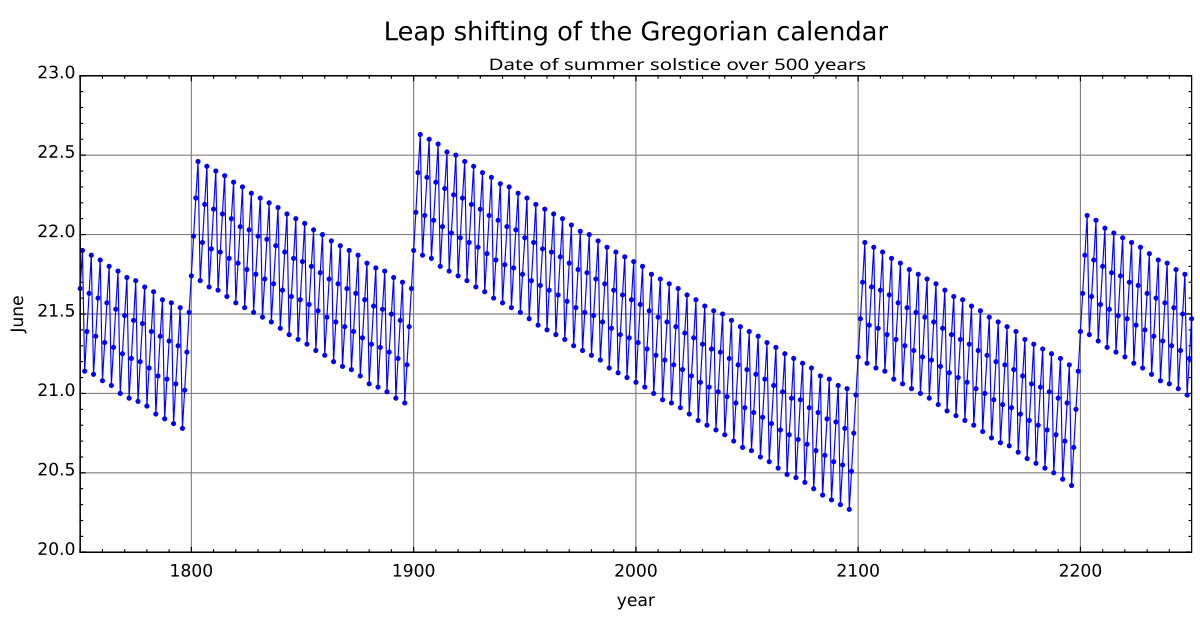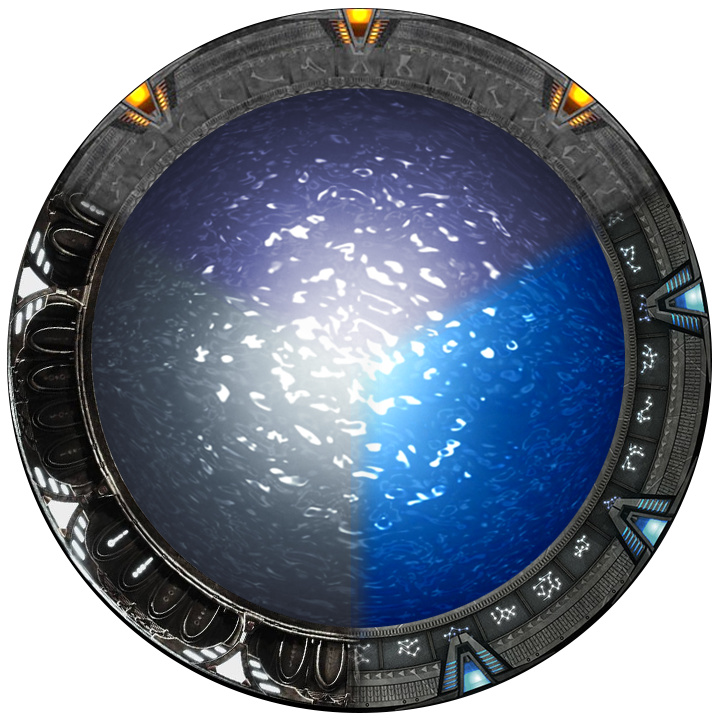Preferably a Holocene colander?
A consensus view was formally adopted by the IUGS in 2013, placing its start at 11,700 years before 2000 (9701 BC), about 300 years more recent than the epoch of the Holocene calendar.[6]
Some problems with Gregorian calendar
The Gregorian calendar improves the approximation made by the Julian calendar by skipping three Julian leap days in every 400 years, giving an average year of 365.2425 mean solar days long.[82] This approximation has an error of about one day per 3,030 years[s] with respect to the current value of the mean tropical year. However, because of the precession of the equinoxes, which is not constant, and the movement of the perihelion (which affects the Earth’s orbital speed) the error with respect to the astronomical vernal equinox is variable; using the average interval between vernal equinoxes near 2000 of 365.24237 days[83] implies an error closer to 1 day every 7,700 years. By any criterion, the Gregorian calendar is substantially more accurate than the 1 day in 128 years error of the Julian calendar (average year 365.25 days).
In the 19th century, Sir John Herschel proposed a modification to the Gregorian calendar with 969 leap days every 4,000 years, instead of 970 leap days that the Gregorian calendar would insert over the same period.[84] This would reduce the average year to 365.24225 days. Herschel’s proposal would make the year 4000, and multiples thereof, common instead of leap. While this modification has often been proposed since, it has never been officially adopted.[85]
On time scales of thousands of years, the Gregorian calendar falls behind the astronomical seasons. This is because the Earth’s speed of rotation is gradually slowing down, which makes each day slightly longer over time (see tidal acceleration and leap second) while the year maintains a more uniform duration.
Calendar seasonal error Gregorian calendar seasons difference

This image shows the difference between the Gregorian calendar and the astronomical seasons.
The y-axis is the date in June and the x-axis is Gregorian calendar years.
Each point is the date and time of the June solstice in that particular year. The error shifts by about a quarter of a day per year. Centurial years are ordinary years, unless they are divisible by 400, in which case they are leap years. This causes a correction in the years 1700, 1800, 1900, 2100, 2200, and 2300.
For instance, these corrections cause 23 December 1903 to be the latest December solstice, and 20 December 2096 to be the earliest solstice—about 2.35 days of variation compared with the astronomical event.
Proposed reforms The following are proposed reforms of the Gregorian calendar:
Holocene calendar
International Fixed Calendar (also called the International Perpetual calendar)
World Calendar
World Season Calendar
Leap week calendars
Pax Calendar
Symmetry454
Hanke–Henry Permanent Calendar
Days are local to the object: moon or planet.
Years… Also local.
There will be conversion factors and differing methods to note time. Gregorian works just fine if we do the occasional extra skip and we have thousands of years to find out how higher ocean levels change the rate of change.
Honestly great write up…
But going with the easy way out— we’d end up having 2…. Maybe. The people on Planet X would need a earth calendar to keep track of things back in mission control; and you’d have the local calendar for local things
Similar to how the mars rover teams do now. While the mission follows mars time; they live on earth.
So depending on what you do; you’d likely have two watches or clocks and calendars.
I think it would be pretty trivial for most of the devices we have now to display a second time standard, it be as simple as pushing a button to switch between the two, if not easier.
Great analysis, but you’re making it way more complicated than it is.
We are entrenched with the Gregorian calendar. The same way we are entrenched with the 12/24hr clock, decimal counting system, etc.
Any planet that needs a calendar will have their own based on the planet’s orbit and rotation, but they will still be tied to the earth calender for as long as they are in contact with earth.
Even simpler than that. Contracts will constrained at having a year of leeway, unless two systems can agree to a version of the best guess of the Gregorian.
Meanwhile the emperor controls the spacers/spice and the date is whatever he wants it to be.
Dune?
I haven’t read the books. Are they still in contact with Earth?
Ditch days, months, years; at least in space. Enjoy the second.
We currently use three primary units of time: day, month, year. They don’t divide well by each other, as shown in your post, but since they refer to things that we experience, they’re still useful.
Outside Earth, however, they lose meaning. So might as well ditch all of them, and stick to the nearest of a standard that we got - a day divided by 24, then 60, then 60. Also known as “the second”. Then just measure things by that; for example Darwin was around 2.3 Gs old when he died (73y; a gigasecond is around 32y).
Then all that’s left is deciding on an origin. The start of the Holocene is fine, but so is anything else. Even mythological - as long as people agree on when Kronos castrated Ouranos, you could use it as the origin if you wanted.
1970-01-01. We’ve sorted this ages ago.
Unix time? I’m a bigger fan of 1993-09-01 for the origin. Then we tell negative and positive dates apart by calling them “August” and “September”.
[This comment was written on September 978Ms]
You also have to standardize that second to a measurable physical phenomenon (crystal vibrations are already a thing, as well as atomic clocks) but then you also have to account for time dialation anytime you want to convert from say mars or moon time to earth time.
NASA recently began work standardizing a moon time standard; since time zones would be different, days wouldn’t really be a useful measurement, etc.
It’s already standardised this way; it’s called the caesium standard. We could also use another unit; as long as it’s one primary unit instead of three it should be fine.
The Plank time could be interesting as a primary unit, too. We could for example call 10⁴³ Plank times by some random name, like “blargh”, and then work around it. (For reference a blargh would be half second, since the Plank time is 5.39*10⁻⁴⁴s)
Taking relativity into account sounds like a big pain to be honest.
And developers thought timezones are hard now…
Pfft amateurs
Because there is lower gravity on the moon than on Earth, time there moves slightly faster — 58.7 microseconds faster every day.
“Day” and “year” have local equivalents for any orbiting, revolving body. We’d probably retain the second as the basic unit of time and maybe go to something like decimal time as a generic standard for communicating between places and for trade and business. That covers spans of time. For absolute time, we may be out of luck. Even assuming we could pick a standard object and point in time as anchors, relativity means that each frame of reference has clocks moving at their own speeds. So far as we know, there is no universal frame of reference.
So even if we said “every revolution of the pulsar at coordinates blahblahblah is one galactic standard day and we define Year 0 as starting exactly 3237.95 standard days ago” we still wouldn’t have a universal time standard because people close to black holes will have seen fewer rotations of the pulsar, so they’d be living in the pasts of any planets in a faster frame of reference.
Even assuming we could pick a standard object and point in time as anchors, relativity means that each frame of reference has clocks moving at their own speeds. So far as we know, there is no universal frame of reference.
It’s not hard to keep clocks ‘synchronized’. the GPS system relies on being kept synchronized very precisely, despite being a couple dozen or so clocks that are constantly moving through their own inertial frames. (remember, GPS works by knowing the precise position of the satellites, and them broadcasting a time-stamped message. You then use that to determine how long the message took, and their relative times from at least three of them to pinpoint your place on the surface.)
It’s not like they have to be quantum entangled or whatever so that they’re constantly reporting the exact same time. For industrial, commercial, and social purposes… fudging things by adding ‘make up time’ into a local day (or subtracting it,) to keep weeks and months in sync are “good enough”, and for scientific purposes requiring exactitudes, well, there’s solutions there.
We already use time zones on earth which alter depending on our relationship with the earth tilt and rotation. I imagine well dontge same. Well use earth time as a reference and adjust our ‘time zone’ to life away from earth.
Obviously, if another time system makes sense in another place, wed adapt to that specific place, but I think it would still be referenced to earth time.
Should we meet others with different measuring systems, maybe wed have to adapt ours and theirs to be mutually comprehensible but similarly, I don’t think we would change of still using a circadian rhythm for life.
You’re asking like three different questions in one.
- What is year one? (You mentioned the Holocene calendar)
- When are leap years? (Proleptic Gregorian calendar)
- What day/month system works on other planets?
The answers to these are,
- It doesn’t matter what we call year one. It’s a bike shedding argument ultimately. Perhaps year one on another planet is the year it is colonized.
- Planets may or may not need leap years, depending on the ratio of days to years.
- Each planet would likely have its own day/month system because their orbits are so different.
All dates would have a conversion to earth dates or something like Julian star dates (as opposed to Julian accounting dates which is just the day of the year). In the same way we convert local timezones to others or UTC, we’d have the same concept for interplanetary communication. In the same way there are some people who (in my opinion foolishly) advocate to stop using timezones, some people may argue to use Julian (star) dates for all time based communication and to never use days, months, years, etc. again.
If the gravity is different enough, having a calendar that keeps track of both local and distant time would become a nightmare.









